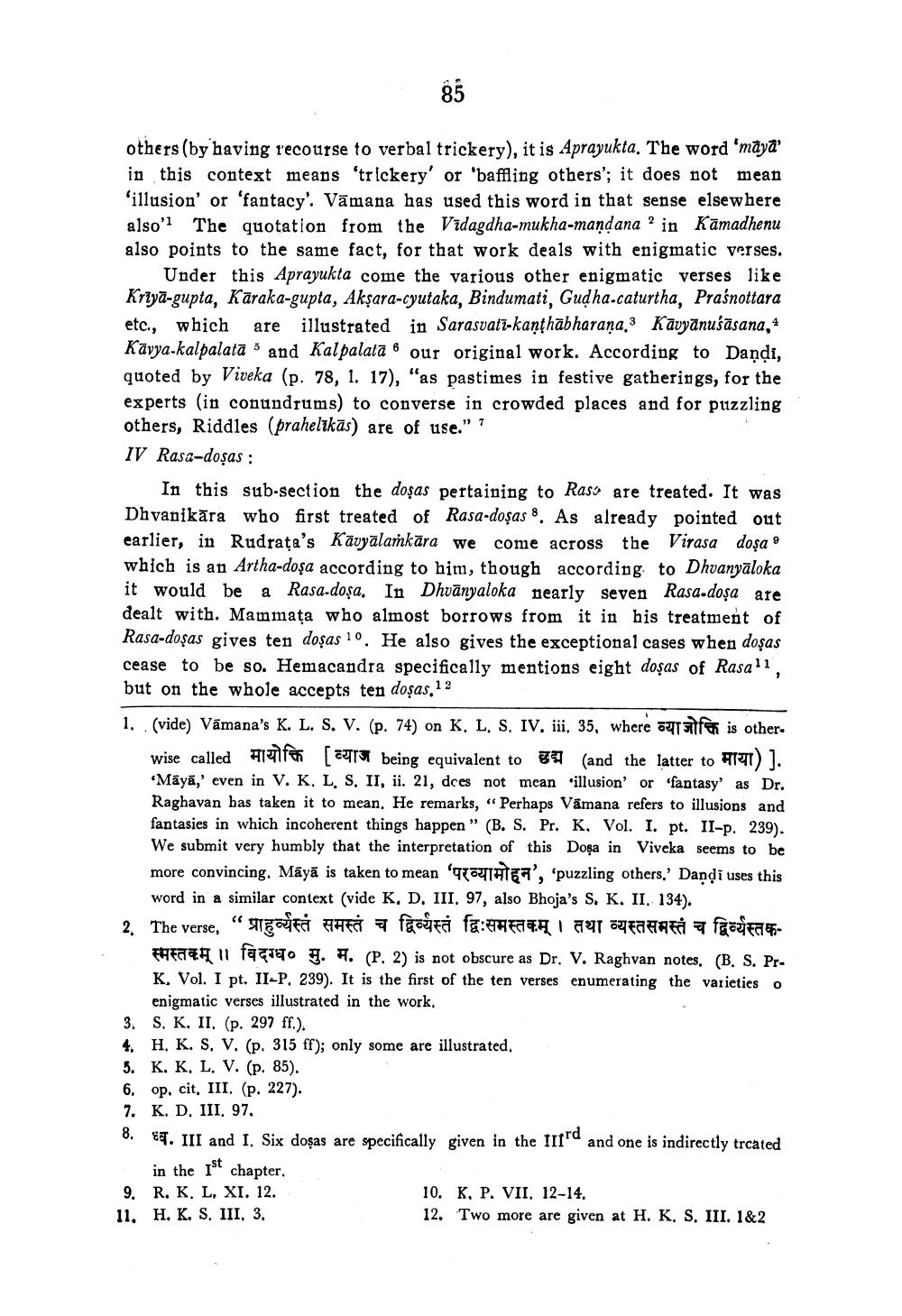________________ others (by having recourse to verbal trickery), it is Aprayukta. The word 'maya in this context means 'trickery' or 'baffling others'; it does not mean 'illusion' or 'fantacy'. Vamana has used this word in that sense elsewhere also' The quotation from the Vidagdha-mukha-mandana ? in Kamadhenu also points to the same fact, for that work deals with enigmatic verses. Under this Aprayukta come the various other enigmatic verses like Kriya-gupta, Karaka-gupta, Aksara-cyutaka, Bindumati, Gud ha.caturtha, Prasnottara etc., which are illustrated in Sarasvati-kanthabharana,3 Kavyanusasana, 4 Kavya-kalpalata 5 and Kalpalata 6 our original work. According to Dandi, quoted by Viveka (p. 78, 1. 17), "as pastimes in festive gatherings, for the experts (in conundrums) to converse in crowded places and for puzzling others, Riddles (prahelikas) are of use." IV Rasa-dosas : In this sub-section the dosas pertaining to Rass are treated. It was Dhvanikara who first treated of Rasa-dosas 8. As already pointed out earlier, in Rudrata's Kavyalamkara we come across the Virasa dosa' which is an Artha-dosa according to him, though according to Dhvanyaloka it would be a Rasa-dosa. In Dhuanyaloka nearly seven Rasa-dosa are dealt with. Mammata who almost borrows from it in his treatment of Rasa-dosas gives ten dosas 10. He also gives the exceptional cases when dosas cease to be so. Hemacandra specifically mentions eight dosas of Rasa'i, but on the whole accepts ten dosas, 1 2 1. (vide) Vamana's K. L. S. V. (p. 74) on K. L. S. IV, iii, 35, where his is other. wise called मायोक्ति [व्याज being equivalent to उद्म (and the latter to माया)]. Maya,' even in V. K, L, S. II, ii. 21, does not mean 'illusion' or 'fantasy' as Dr. Raghavan has taken it to mean. He remarks, "Perhaps Vamana refers to illusions and fantasies in which incoherent things happen " (B. S. Pr. K. Vol. I. pt. Il-p. 239). We submit very humbly that the interpretation of this Dosa in Viveka seems to be more convincing. Maya is taken to mean T741477', 'puzzling others.' Danli uses this word in a similar context (vide K, D, III, 97, also Bhoja's S. K. II. 134). 2. The verse, "EF AHF fogta farra i agt utanti facuta Fra 11 facto H. H. (P. 2) is not obscure as Dr. V. Raghvan notes. (B. S. PrK. Vol. I pt. II-P, 239). It is the first of the ten verses enumerating the varieties o enigmatic verses illustrated in the work, 3. S. K. II. (p. 297 ff.). 4. H. K. S. V. (p. 315 ff); only some are illustrated. 5. K. K. L. V. (p. 85). 6. op. cit. III. (p. 227). 7. K. D. III. 97. 8. 9. III and I. Six dosas are specifically given in the titra and one is indirectly trcated in the ist chapter 9. R, K, L, XI. 12. 10. K, P. VII. 12-14. 11. H. K. S. III, 3. 12. Two more are given at H. K. S. III. 1&2




